Pad Woon Sen may not be as well-known as Pad Thai, but it deserves just as much love. Silky glass noodles are stir-fried with crisp veggies, tender chicken, and scrambled egg, all tossed in a savory Thai-style sauce.
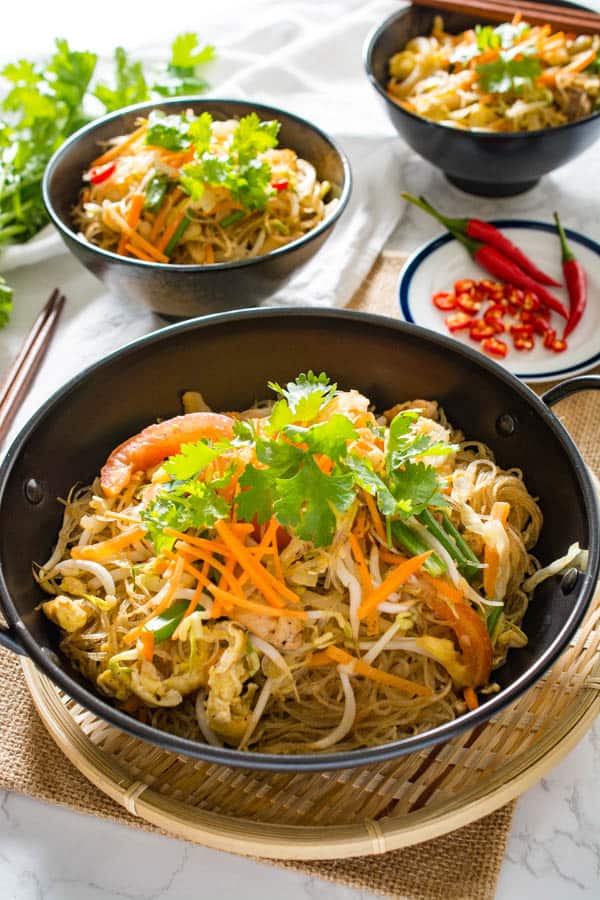
Pad Woon Sen is one of those dishes that always hits the spot. Comforting, savory, and surprisingly quick to make. This Thai-style glass noodle stir-fry comes together in just 30 minutes, and it’s a great way to use up whatever veggies and protein you have in the fridge.
If you're a fan of Pad Thai, Pad Woon Sen is its underrated glass noodle cousin — lighter, faster, and just as satisfying.
The glass noodles soak up all that savory sauce, while the mix of crisp vegetables and scrambled egg adds a satisfying contrast in texture.
These noodles have a texture similar to Korean Japchae but are more delicate and thinner, offering a softer bite that pairs perfectly with the vibrant, crisp vegetables and tender protein.
I like to toss in a little Thai bird chili for heat and finish with fresh cilantro for a bright, herby kick.
If you’ve only had Pad Woon Sen at Thai restaurants, you’ll be surprised how easy it is to make at home. This step-by-step recipe will guide you through the process so you can bring the bold, comforting flavors of Thai glass noodles right into your own kitchen.
This easy Thai dinner is just as satisfying as your favorite takeout, but comes together in one pan with simple pantry ingredients.
What type of noodles are used in Pad Woon Sen?
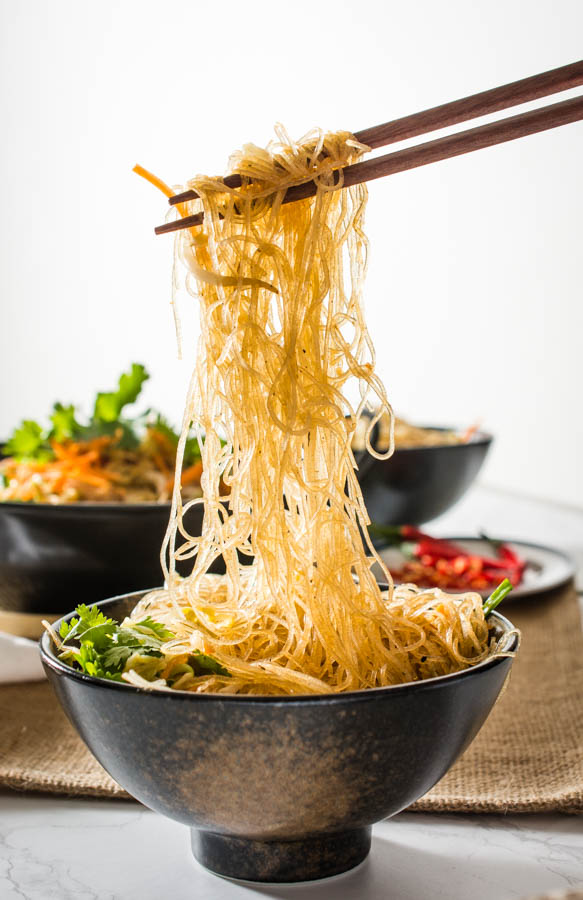
Glass noodles, also known as bean thread noodles or cellophane noodles, are a staple in many Asian cuisines, and they’re what you’ll need for Pad Woon Sen.
Made from mung bean starch, these noodles turn almost completely transparent when cooked, giving them their signature “glass” appearance. They have a silky, smooth texture that soaks up the sauce beautifully, making them perfect for stir-fried dishes like this one.
PRO TIP: Don’t confuse glass noodles (bean thread noodles) with rice vermicelli or rice noodles! They can look very similar when dry, and they’re often stocked side-by-side at Asian grocery stores. Always double-check the labels to make sure you’re picking the right kind for the recipe you’re making.
Rice vermicelli turns opaque when cooked, while glass noodles become translucent. Glass noodles also have a starchier, slightly chewy texture — similar to the sweet potato noodles used in Korean Japchae, but thinner and more delicate.
How to Make Pad Woon Sen
Start by soaking about 160g of dried glass noodles (bean thread noodles) in room-temperature or slightly warm water for 10 minutes while you prep the other ingredients (I don’t recommend using hot water for this process because it softens them too quickly and can lead to mushy noodles after they’re cooked).
Once they’ve softened, drain and set them aside.
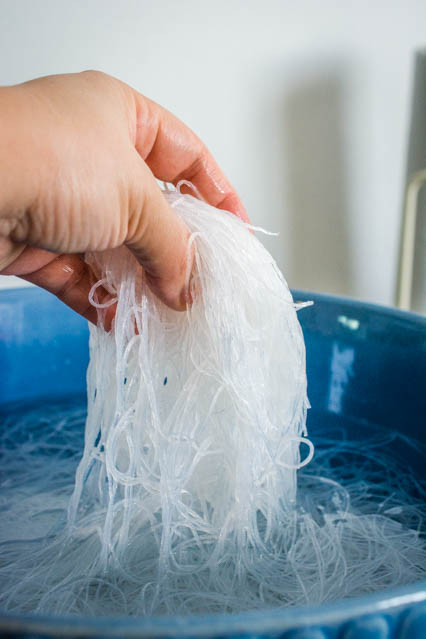
In a small bowl, mix together 2 tablespoons of water, 2 tablespoons of oyster sauce, 1 tablespoon of soy sauce, 1 teaspoon fish sauce, 1 teaspoon of sugar, and a dash of ground white pepper.
Stir to combine and set the sauce aside for now.
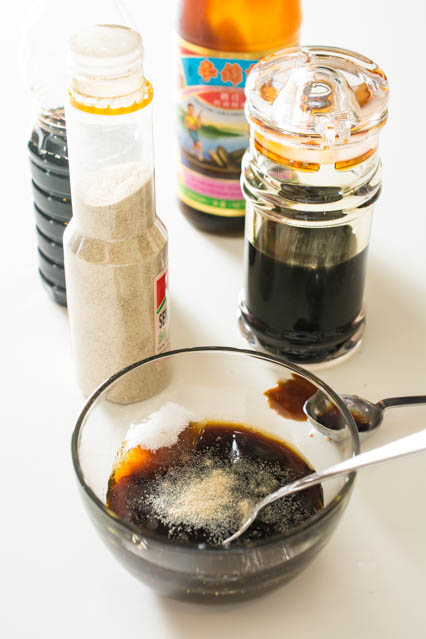
Crack 2 eggs into a bowl and beat them lightly.
Heat about 2 tablespoons of neutral oil in a wok over medium-high heat, then pour in the eggs. Let them sit undisturbed for 30 seconds to allow them to set slightly before scrambling.
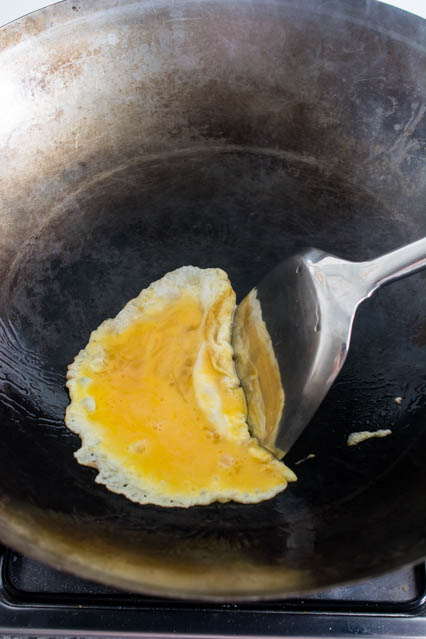
I like leaving the pieces on the larger side so you get little pockets of egg throughout the noodles, but break them up to your liking. Once cooked, remove the eggs from the wok and set aside.
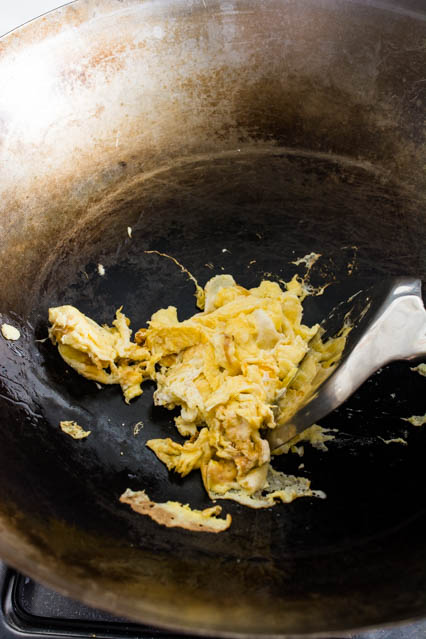
Add a bit more oil to the wok, then toss in about ¾ cup of diced chicken thighs.
Stir-fry for a couple of minutes until the chicken is mostly cooked through, then add a splash of soy sauce (about 1 teaspoon) for extra flavor and color.
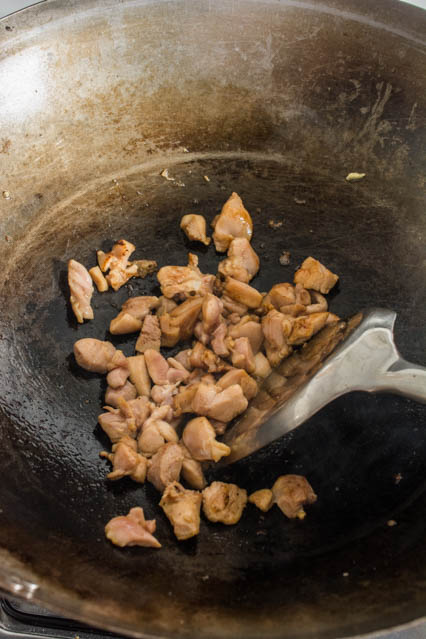
Would you like to save this?
Next, add one small sliced onion and three cloves of minced garlic. Keep stir-frying until the onion softens and starts to turn translucent.
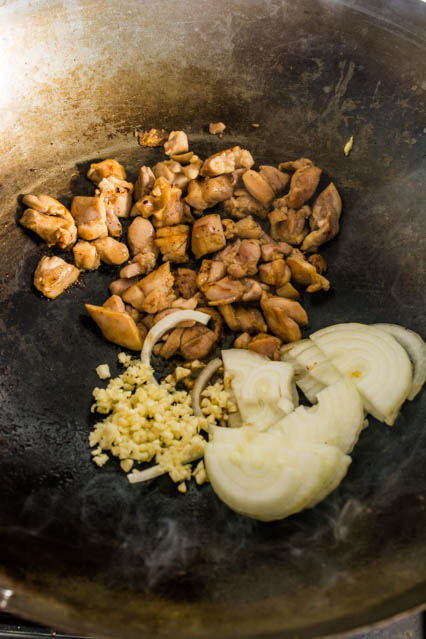
Push everything to the side of the wok and add 1 cup of julienned carrot and 1 cup of shredded cabbage. You can use a pre-cut coleslaw mix here to save time; that works perfectly.
Stir everything together for another minute or two, just until the vegetables begin to soften slightly.
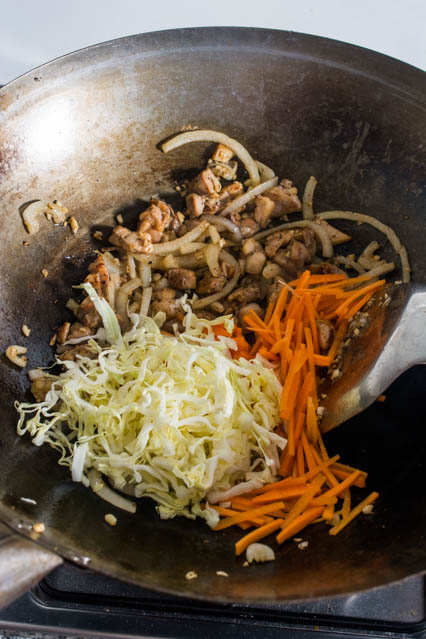
Toss in one tomato, cut into wedges, and give it a quick stir to warm through.
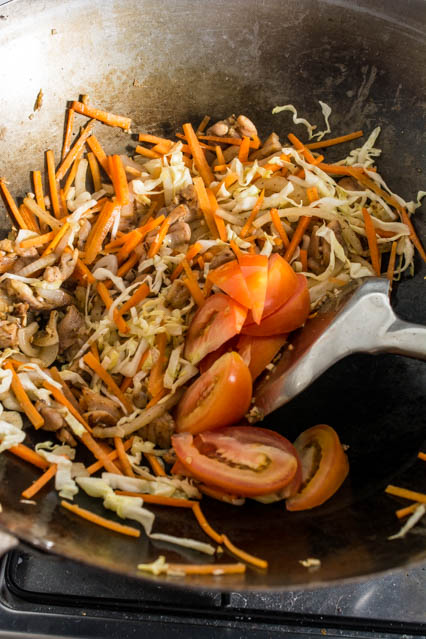
Add the soaked and drained glass noodles to the wok, right on top of the chicken and vegetables.
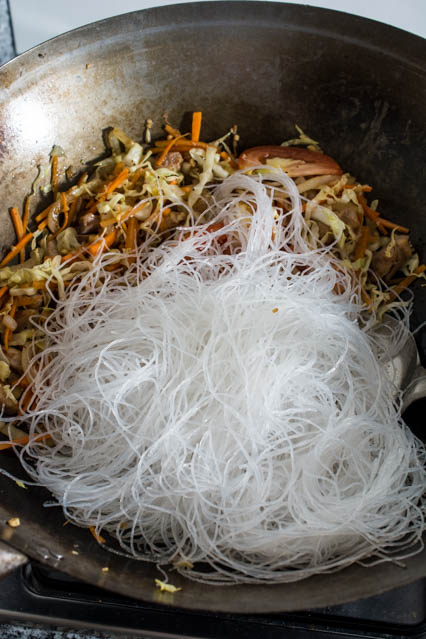
Pour the sauce over the noodles, then use tongs or a wok spatula to toss everything together until the noodles are evenly coated and the sauce is well distributed.
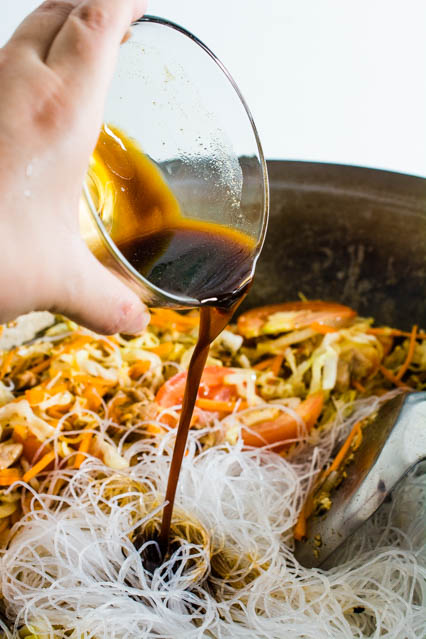
Return the scrambled eggs to the wok, then add 2 cups of fresh bean sprouts and 2 stalks of scallions, cut into 1-inch pieces.
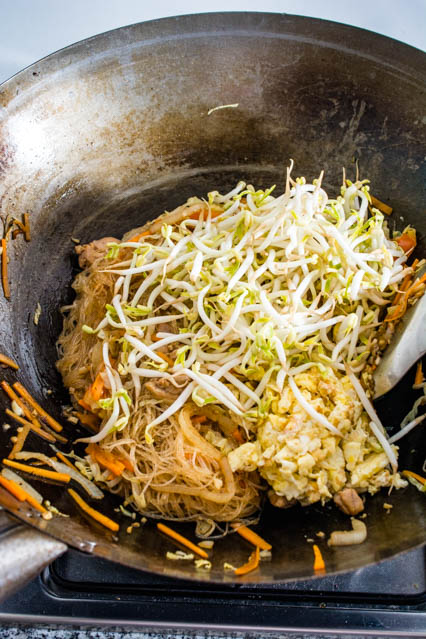
Give everything one final toss to combine — the residual heat will gently cook the bean sprouts and scallions while keeping them crisp.
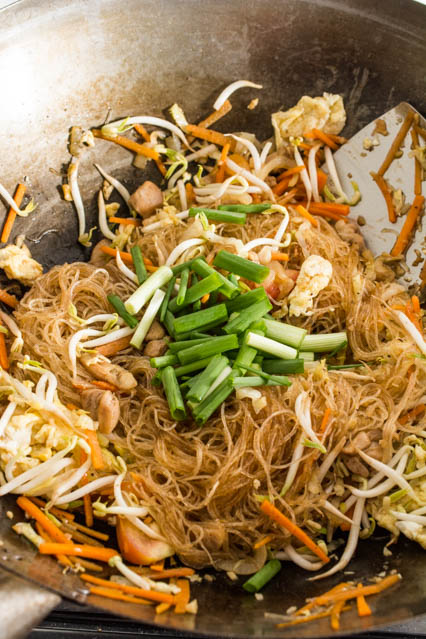
Transfer the noodles to a serving dish and top with fresh cilantro and thinly sliced Thai bird chili if you like a bit of heat. Serve immediately.
Pad Woon Sen is one of those recipes that’s easy to fall back on — quick enough for a weeknight, but full of bold flavor and just the right mix of textures.
Once you’ve got glass noodles in your pantry, the rest comes together with whatever veggies and protein you have on hand.
If you’ve never cooked with glass noodles before, this is a great place to start. It’s a flexible, forgiving dish that always hits the spot — and you’ll be surprised by how simple it is to recreate your favorite Thai stir-fry at home.
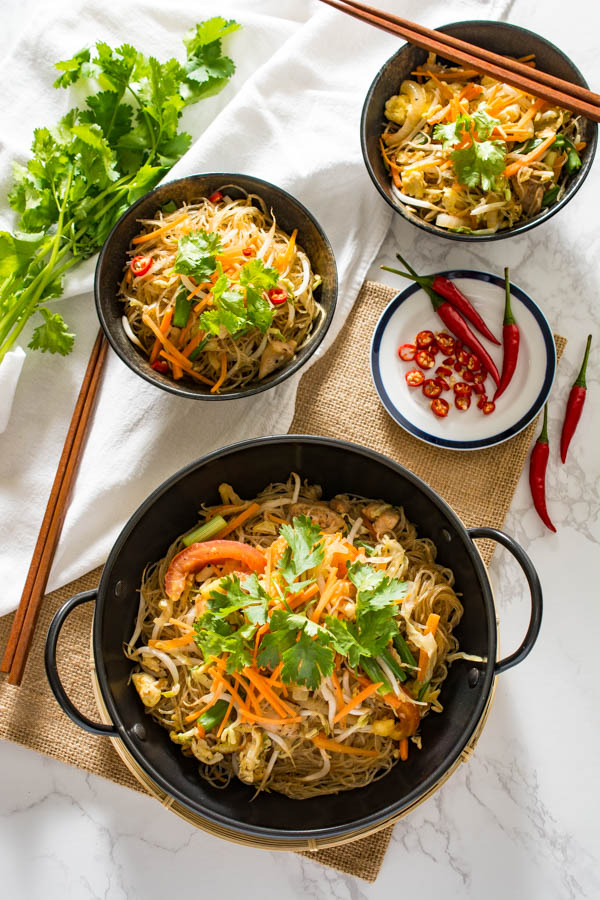
💡 Pro Tips for the Best Pad Woon Sen
Don’t over-soak the noodles. Stick to room temp or slightly warm water, and soak just until pliable — usually around 10 minutes. Too long, and they’ll turn mushy when stir-fried.
Work quickly once the noodles go in. Glass noodles are a little sticky by nature, so toss them with the sauce as soon as they hit the wok to keep them from clumping.
Prep everything before you start cooking. This stir-fry comes together fast, so having your veggies chopped and sauce mixed ahead of time makes things a lot smoother.
Adjust the sauce to taste. Taste as you go! If you like it saltier, add a splash of fish sauce at the end. A pinch of sugar can also help round things out if it needs a little balance.
Use high heat. A hot wok helps everything cook quickly without steaming. It also helps bring out the flavor in the sauce and keeps the veggies crisp.
Frequently Asked Questions
Yes, you can substitute sweet potato noodles if that’s what you have on hand. The dish will still taste great, though the texture will be a little different. Sweet potato noodles are thicker and chewier than glass noodles, so the final result will be heartier and slightly bouncier.
Store leftovers in an airtight container in the fridge for up to 2 days. To reheat, add a splash of water to loosen the noodles and warm gently in a pan over medium heat.
Yes! You can chop all the vegetables and mix the sauce ahead of time. Just wait to soak the glass noodles until right before cooking because if they sit too long, they can turn mushy.
You can mix and match veggies depending on what you have in your fridge. Bell peppers, snap peas, shiitake mushrooms, baby corn, and broccoli are all great options. Just try to keep it to two or three types so the dish doesn’t get too crowded.
Yes! For a vegetarian version, skip the fish sauce and use a vegetarian oyster sauce or more soy sauce.
To make it gluten-free, double-check your sauces — look for gluten-free soy sauce (or tamari) and a gluten-free oyster sauce if using. The glass noodles themselves are naturally gluten-free.
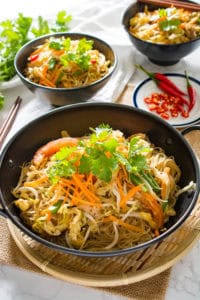
Pad Woon Sen
Ingredients
- 160 grams bean thread noodles dried
- 2 eggs lightly beaten
- 2-3 tablespoons cooking oil
- ¾ cup chicken thighs cut into small pieces
- 1 onion small, sliced
- 1 teaspoon soy sauce
- 3 cloves garlic minced
- 1 cup carrots julienned
- 1 cup cabbage shredded
- 1 tomato cut into wedges
- 2 cups bean sprouts
- 2 stalks scallions cut into 1-inch pieces
Sauce
- 2 tablespoons water
- 2 tablespoons oyster sauce
- 1 tablespoons soy sauce
- 1 teaspoon fish sauce
- 1 teaspoon sugar
- 1 dash ground white pepper
Garnish
- cilantro
- 3 - 4 Thai bird chili sliced
Instructions
- Place the glass noodles in room-temperature or slightly warm water and soak for about 10 minutes, just until they’re pliable. Drain and set aside.
- In a small bowl, mix oyster sauce, soy sauce, fish sauce, water, sugar, and white pepper. Stir well and set aside.
- Heat a bit of oil in a wok over medium-high heat. Add the beaten eggs and let them sit for 30 seconds before scrambling. Cook until just set, then remove from the wok and set aside.
- Add more oil to the wok, then stir-fry the chicken until mostly cooked. Add a splash of soy sauce for flavor and color.
- Add onion and garlic to the wok. Continue to stir-fry until the onions are slightly translucent and the chicken has cooked all the way through.
- Add carrot and cabbage (or coleslaw mix). Stir-fry briefly until slightly softened. Add tomato and stir to warm through.
- Place the drained glass noodles in the wok. Pour the sauce over the noodles and toss well to combine.
- Return the scrambled eggs to the wok, then add bean sprouts and scallions.
- Toss everything together until well mixed and heated through.
- Transfer to a serving bowl. Garnish with cilantro and Thai bird chili.

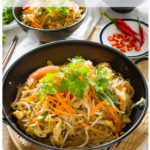
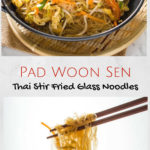

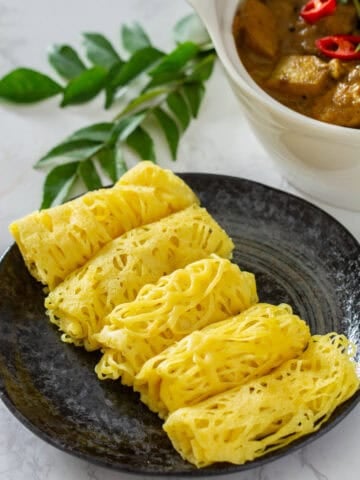


Melody says
Can this be made without the fish sauce?
Char says
Hi Melody. Yes, it is fine to omit the fish sauce if you prefer. It's a bit difficult to replicate that fish sauce flavor but you can add a bit of lime juice and just a bit more soy sauce in its place.